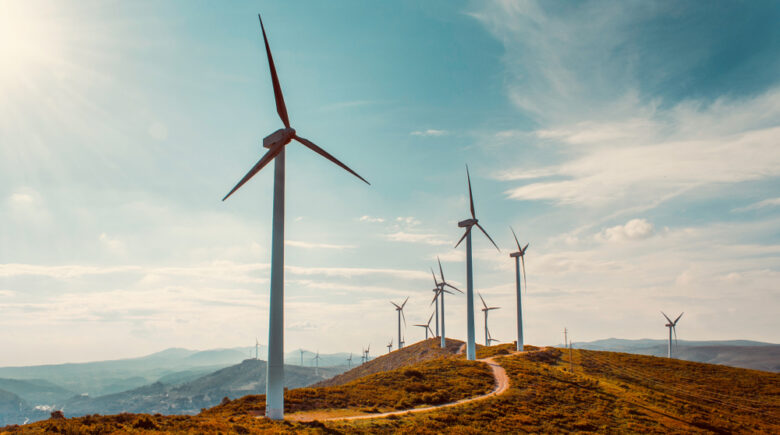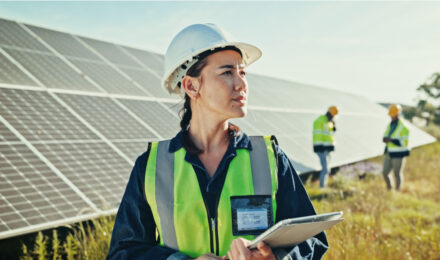Wind energy is a renewable source of power that is harnessed from the movement of air generated by the sun’s uneven heating of the Earth’s surface. Wind energy has become one of the most promising renewable energy sources in recent years, and it has the potential to meet a significant portion of our energy needs.
Types of Wind Energies
There are two primary kinds of wind turbines: horizontal-axis wind turbines (HAWTs) and vertical-axis wind turbines (VAWTs). HAWTs are the most popular kind of wind turbine, and they are designed to have the rotor blades rotate around a horizontal axis. These turbines are typically taller and have a larger rotor diameter than VAWTs, and they can generate more electricity. On the other hand, VAWTs have rotor blades that rotate around a vertical axis, and they are typically shorter and have a smaller rotor diameter than HAWTs. VAWTs are also less affected by wind direction changes and turbulence, and they can be installed in urban areas due to their smaller size. Other types of wind energy include:
Floating Wind Energy: Floating wind turbines are a new technology currently being developed. These turbines are designed to float on the water’s surface, allowing them to be installed in deeper waters where traditional offshore wind turbines cannot. Floating wind turbines have the potential to generate even more electricity than traditional offshore turbines, but they are still in the early stages of development.
Small Wind Energy: Small wind turbines generate electricity for individual homes, businesses, and communities. These turbines are typically smaller in size and have a capacity of a few kilowatts. Small wind turbines can be installed on rooftops, backyards, or on small land. They are specifically useful in remote areas where connecting to the electrical grid is not practical.
Community Wind Energy: Community wind energy projects are owned and operated by local communities, typically in rural areas. These projects are designed to generate electricity for the local community and are often financed through community ownership or cooperatives. Community wind energy projects can range from a few turbines to large-scale wind farms.
Major Applications of Wind Energy
Wind power has a wide range of applications and is commonly used for electricity generation. Wind turbines can be installed in large wind farms or on a smaller scale, such as in residential or commercial buildings. Wind energy is also used for water pumping, particularly in rural areas where there is no access to electricity. Wind turbines can be connected to water pumps, and the energy generated by the wind can be used to pump water from wells or other sources.
Another major application of wind power is in the transportation sector. Wind energy can power ships, particularly cargo ships that transport goods worldwide. These ships have large sails that capture the wind and convert it into energy, minimizing reliance on fossil fuels and decreasing the shipping industry’s carbon footprint.
Advantages of Wind Energy
Wind energy is a renewable energy source that has become increasingly common because of its many advantages. Some of the primary advantages of wind power include:
Renewable and Sustainable: Wind power is a renewable energy source that can be replenished naturally over time. This makes it a sustainable source of energy that does not contribute to greenhouse gas emissions, air pollution, or climate change. As the world’s fossil fuel reserves are depleted, renewable energy sources like wind power are becoming increasingly important.
Low Environmental Impact: Wind turbines have a low environmental impact compared to other forms of energy production, such as fossil fuels. Wind turbines do not emit harmful pollutants into the air or water and do not produce toxic waste products that can harm the environment. This makes wind power an environmentally friendly option for energy production.
Low Operating Costs: Once a wind turbine is installed, the operating costs are relatively low compared to other forms of energy production. Wind energy is free, so the only costs associated with wind power are those associated with maintenance and repairs. Wind turbines have a longer lifespan than other forms of energy production, so the maintenance costs are spread out over a more extended period.
Job Creation: Wind power can create many jobs in the renewable energy sector. The installation, maintenance, and operation of wind turbines require a range of skilled workers, from engineers to technicians to project managers. Wind power can create jobs in urban and rural areas, providing employment opportunities for people with various skills and experience.
Energy Security: Wind power can increase energy security by reducing dependence on imported fossil fuels. Wind power can provide a reliable source of energy that is not subject to price fluctuations or supply interruptions. This can reduce the risk of energy shortages and blackouts, particularly in areas that rely heavily on imported fossil fuels.
Scalability: Wind power is a scalable technology that can be deployed on a small or large scale. Small wind turbines can be installed on individual homes or businesses, while large wind farms can generate electricity for entire communities or regions. This scalability makes wind power a flexible technology that can be adapted to meet the energy needs of different communities and regions.
Improved Public Health: Wind power can improve public health by reducing air pollution and greenhouse gas emissions. Fossil fuel combustion is a main source of air pollution, which can cause respiratory problems, cardiovascular disease, and other health issues. Wind power can reduce the amount of fossil fuels burned for energy production, improving air quality and reducing the health risks associated with air pollution.
Conclusion
Wind power is a renewable and sustainable source of energy that offers many advantages over traditional forms of energy production. Wind power is environmentally friendly, has low operating costs, creates jobs, enhances energy security, is scalable, and improves public health. As the world turns towards renewable energy sources, wind power will likely play an increasingly important role in meeting our energy needs.
Wind energy is a renewable source of power that is harnessed from the movement of air generated by the sun’s uneven heating of the Earth’s surface. Wind energy has become one of the most promising renewable energy sources in recent years, and it has the potential to meet a significant portion of our energy needs.
Types of Wind Energies
There are two primary kinds of wind turbines: horizontal-axis wind turbines (HAWTs) and vertical-axis wind turbines (VAWTs). HAWTs are the most popular kind of wind turbine, and they are designed to have the rotor blades rotate around a horizontal axis. These turbines are typically taller and have a larger rotor diameter than VAWTs, and they can generate more electricity. On the other hand, VAWTs have rotor blades that rotate around a vertical axis, and they are typically shorter and have a smaller rotor diameter than HAWTs. VAWTs are also less affected by wind direction changes and turbulence, and they can be installed in urban areas due to their smaller size. Other types of wind energy include:
Floating Wind Energy: Floating wind turbines are a new technology currently being developed. These turbines are designed to float on the water’s surface, allowing them to be installed in deeper waters where traditional offshore wind turbines cannot. Floating wind turbines have the potential to generate even more electricity than traditional offshore turbines, but they are still in the early stages of development.
Small Wind Energy: Small wind turbines generate electricity for individual homes, businesses, and communities. These turbines are typically smaller in size and have a capacity of a few kilowatts. Small wind turbines can be installed on rooftops, backyards, or on small land. They are specifically useful in remote areas where connecting to the electrical grid is not practical.
Community Wind Energy: Community wind energy projects are owned and operated by local communities, typically in rural areas. These projects are designed to generate electricity for the local community and are often financed through community ownership or cooperatives. Community wind energy projects can range from a few turbines to large-scale wind farms.
Major Applications of Wind Energy
Wind power has a wide range of applications and is commonly used for electricity generation. Wind turbines can be installed in large wind farms or on a smaller scale, such as in residential or commercial buildings. Wind energy is also used for water pumping, particularly in rural areas where there is no access to electricity. Wind turbines can be connected to water pumps, and the energy generated by the wind can be used to pump water from wells or other sources.
Another major application of wind power is in the transportation sector. Wind energy can power ships, particularly cargo ships that transport goods worldwide. These ships have large sails that capture the wind and convert it into energy, minimizing reliance on fossil fuels and decreasing the shipping industry’s carbon footprint.
Advantages of Wind Energy
Wind energy is a renewable energy source that has become increasingly common because of its many advantages. Some of the primary advantages of wind power include:
Renewable and Sustainable: Wind power is a renewable energy source that can be replenished naturally over time. This makes it a sustainable source of energy that does not contribute to greenhouse gas emissions, air pollution, or climate change. As the world’s fossil fuel reserves are depleted, renewable energy sources like wind power are becoming increasingly important.
Low Environmental Impact: Wind turbines have a low environmental impact compared to other forms of energy production, such as fossil fuels. Wind turbines do not emit harmful pollutants into the air or water and do not produce toxic waste products that can harm the environment. This makes wind power an environmentally friendly option for energy production.
Low Operating Costs: Once a wind turbine is installed, the operating costs are relatively low compared to other forms of energy production. Wind energy is free, so the only costs associated with wind power are those associated with maintenance and repairs. Wind turbines have a longer lifespan than other forms of energy production, so the maintenance costs are spread out over a more extended period.
Job Creation: Wind power can create many jobs in the renewable energy sector. The installation, maintenance, and operation of wind turbines require a range of skilled workers, from engineers to technicians to project managers. Wind power can create jobs in urban and rural areas, providing employment opportunities for people with various skills and experience.
Energy Security: Wind power can increase energy security by reducing dependence on imported fossil fuels. Wind power can provide a reliable source of energy that is not subject to price fluctuations or supply interruptions. This can reduce the risk of energy shortages and blackouts, particularly in areas that rely heavily on imported fossil fuels.
Scalability: Wind power is a scalable technology that can be deployed on a small or large scale. Small wind turbines can be installed on individual homes or businesses, while large wind farms can generate electricity for entire communities or regions. This scalability makes wind power a flexible technology that can be adapted to meet the energy needs of different communities and regions.
Improved Public Health: Wind power can improve public health by reducing air pollution and greenhouse gas emissions. Fossil fuel combustion is a main source of air pollution, which can cause respiratory problems, cardiovascular disease, and other health issues. Wind power can reduce the amount of fossil fuels burned for energy production, improving air quality and reducing the health risks associated with air pollution.
Conclusion
Wind power is a renewable and sustainable source of energy that offers many advantages over traditional forms of energy production. Wind power is environmentally friendly, has low operating costs, creates jobs, enhances energy security, is scalable, and improves public health. As the world turns towards renewable energy sources, wind power will likely play an increasingly important role in meeting our energy needs.



